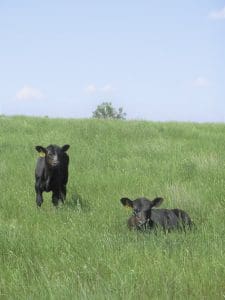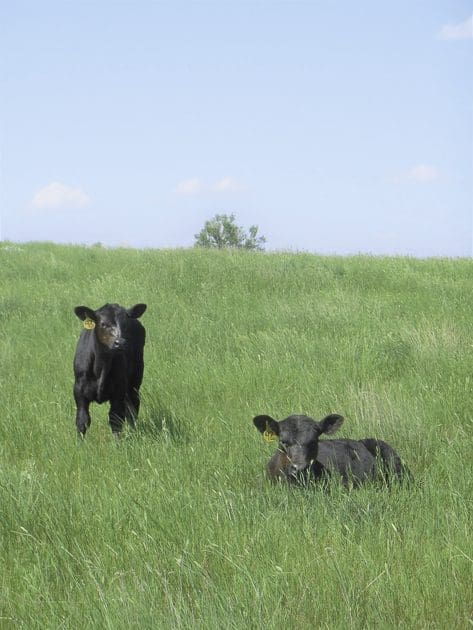By Patti Wilson Contributing Editor

Farm methane digesters are most notably used on large dairies and confinement hog units. They are now becoming a more accepted method of waste management at beef cattle feedlots.
The digesters are large tanks or covered lagoons where livestock waste is stored and broken down by bacteria called archaea to make renewable methane gas. The flammable gas can be used as an on-farm energy source. For example, it may fuel a generator that provides electricity. Some dairies are now providing all of their own energy needs, closing a loop of biological self-sufficiency and creating independence from utility bills.
The efficiency of these systems is demonstrated by a 2016 California law requiring dairy farms to cut methane production from manure storage by 40 percent by 2030. Dairies are already on track to surpass that goal, mostly because of use of digesters, according to researchers at University of California, Davis.
These farm digesters are most commonly large, circular concrete or steel tanks with heavy plastic membrane covers. Increasingly, farms are taking their systems one step further, adding methane digestion to their technology. This process upgrades methane into renewable natural gas (RNG). These units are most commonly covered lagoons working as large-volume liquid storage. Plastic covers trap the biogas produced by bacteria as the manure decomposes. It is estimated that there are more than 270 anaerobic methane digesters currently operating on U.S. dairies. Renewable natural gas is then piped or trucked to energy entities, such as Shell plc, which in turn supplies the gas to heat homes and fuel trucks as a regional energy source. Leftover liquid and solids are called digestate. They are suitable for farm fertilizer, being rich in nitrogen, phosphorus and potassium. The American Biogas Council maintains that the use of digestates as fertilizer can increase crop yields by 10 to 30 percent. Skyrocketing fertilizer costs due to the war in Ukraine are an example of the importance of developing new methods of fertilization.
Differences in animal feedstuffs and digester methods will produce varying chemical compositions in the digestate, so chemical analysis is always advisable. Waste solids may also be used as recycled bedding.
It is estimated that in 2023, a California dairy cow can generate $2,827 per year in pollution and biofuel credits for methane that would otherwise go into the atmosphere.
An additional advantage for farms near population areas is providing a place for hotels, restaurants and institutions to deposit scrap waste from foods. Dairies already implementing this service to the food industry are pleased with the results. The impact of adding scraps to on-farm digesters has a potential to be enormous; a 2021 report by the EPA found that annual carbon dioxide emissions from food waste are equivalent to output from 42 coal-fired power plants.
What Started This?
In 1973, an oil embargo drove fuel prices to record highs. As a result, Cornell University became involved with anaerobic digestion on dairy farms. It was not done as an ecological alternative to offset air pollution by fossil fuels, but as an alternative energy solution to high-priced oil.
Today, a database of renewable energy policies and programs lists 96 financial incentives for anaerobic digesters. Among those are property tax reductions, corporate tax credits, loan programs, grants and performance-based incentives.
The capitol cost for the locally centralized farm methane digester system is about $4.8 million for a typical farm. Capitol cost is the total of the one-time expenses when the project is initiated, which includes collective costs for building the digester itself, pipeline construction, manure transportation equipment and interconnection (connecting and injecting renewable natural gas into the main utility pipeline).
Additional costs may be incurred by expanded office space for digester personnel. These people are often provided courtesy of the energy company and manage the high-tech operation, a separate skillset entirely from livestock production.
What Are the Drawbacks?
Local citizens and edge-of-towners have voiced concerns about potential odors, a possible increase in traffic flow, muddy highways and safety concerns involving the natural gas facilities. Existing entities have proven there is no odor or muddy roads. Much of the gas is moved by underground pipeline, and there have been zero safety-related incidents at any natural gas facility.
There is a slight chance that certain bacteria may survive the digestion process. This makes the use of solids as bedding for lactating cattle a risk for contracting mastitis.
Anaerobic Digesters as Discriminatory Entities
An example of one who cuts off one’s nose to spite their own face, the California government is creating a new stewpot. After pushing hard for the development of anaerobic digesters on livestock farms, they now are back peddling, hard.
A September 20, 2023, article by the Coalition for Renewable Natural Gas reported, “The California Air Resources Board (CARB) is reopening its rulemaking on the Low Carbon Fuel Standard, sparking new debate over the role of dairy digesters in combating climate change. Environmental justice advocates have pushed the board to drop its credits for digesters, calling the incentives a subsidy for industrial farms that allow them to grow larger and pollute disadvantaged communities …” Further, “It hopes to rapidly phase out crop-based feedstocks like ethanol.” (I assume they mean corn). “Yet the issue that gained the most debate during the Environmental Justice Advisory Committee workshop was a request to eliminate methane credits for digesters next year, along with any other potential pathways for dairy and livestock producers to gain credits …”
The Environmental Justice Advisory Committee is an arm of CARB and is made up of prominent environmental interest groups. CARB has an annual budget of more than $500,000 per year.
The November 2023 issue of Hoard’s Dairyman states, ”This month, nearly 200 environmental groups sent a letter to the USDA also condemning the use of federal funds to support digesters. The technology ‘doubles down on pollution, encourages farms to get larger and is a waste of taxpayer resources,’ they said.”
Who Are These People?
According to the California Air Resources Board website, the board consists of “ 14 voting members and two ex officio, nonvoting members who are members of the California Legislature, one from the Senate and the other from the Assembly. Of the 14 voting members, 12 are appointed by the governor with Senate confirmation, and includes six who serve on local air districts, four experts in fields that shape air quality rules, and two public members. The other two voting members represent environmental justice communities and are appointed –one each – by the Senate Rules Committee and the Assembly Speaker. The chair serves as the only full-time member and is appointed by the governor from among the voting members.”
California has a long and complicated list of regulations and laws concerning carbon credits. Removing these credits from livestock producers will potentially force them out of business. It is not hard to see where the state is heading.
We have been labeled the new discriminatory group.







